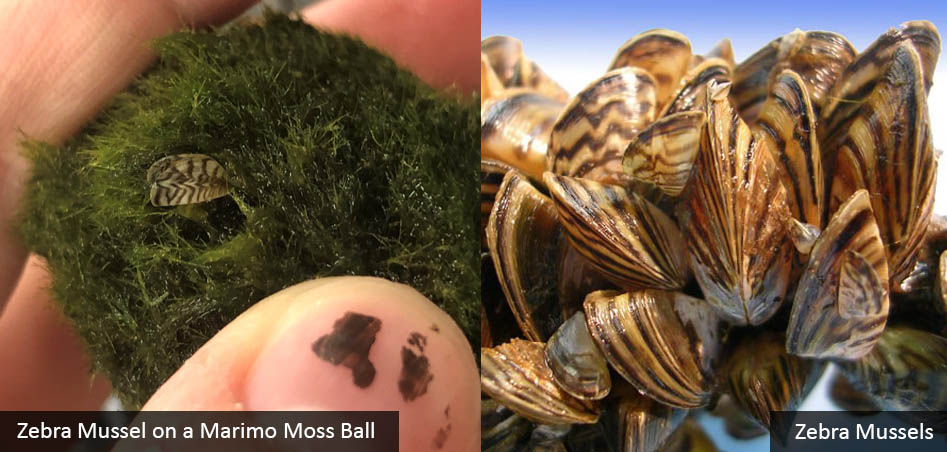
|
(Released: March 04, 2021)
CONTACT: Tammy Davis
Invasive Species Program Coordinator
(907) 465-6183
(Statewide) – The Alaska Department of Fish and Game (ADF&G) is issuing a notification to aquarium owners across the state that zebra mussels (Dreissena polymorpha) were recently discovered attached to live marimo moss balls and may have been sold at pet or aquarium supply stores in the state. Marimo moss balls are living organisms sold nationwide to aquarium hobbyists. These balls of algae are often used as decorative items in aquariums or fish tanks. Zebra mussels can attach to the fibers and survive being transported.
“Zebra mussels are considered a highly invasive species in Alaska and pose a great threat to the state’s freshwater environments,” Tammy Davis, the ADF&G Invasive Species Coordinator, said. “It could be extremely detrimental to aquatic habits in Alaska if zebra mussels were inadvertently introduced in any freshwater system in the state. It is imperative that we take measures to ensure that this does not happen.”
Anyone who has recently purchased or acquired “moss” balls for their aquarium is encouraged to inspect the product for the presence of zebra mussels. If zebra mussels are discovered, remove mussels and “moss” balls from your aquarium, place them in a plastic bag and place the contents in a freezer for at least one day. To avoid potentially serious problems with your home plumbing, please do not dispose of the contents of your aquarium by pouring it down the drain or flushing it down the toilet.
Zebra mussels are thumb-sized invasive freshwater shellfish named for the striped pattern of their shell. They look like tiny D-shaped clams. Zebra mussels can survive in Alaska freshwaters. Prior to this finding, zebra mussels have not been detected in Alaska.
Zebra mussels invaded the Great Lakes Region in the late 1980s and quickly colonized several Great Lakes, most of the Mississippi and some of the Missouri river basins. Zebra mussels can cause widespread damage by fouling shorelines and encrusting aquatic infrastructure like fish passage facilities and aquaculture operations. They are highly efficient filter feeders; large populations in lakes can deplete plankton which disrupts food webs and starves native species.
Once these little bivalves become established, eradication is nearly impossible. Some consider zebra mussels the number one invasive species threat to freshwater environments because of the destruction to salmon habitat and loss of recreational opportunity, and the economic impacts to fisheries, hydropower and drinking water infrastructure, and devaluation of property.
Zebra mussels are not the only aquarium product of concern in Alaska. Aquarium owners are encouraged to dispose of unwanted aquarium fish or plants in a responsible manner to help stop the spread of aquatic invasive species in Alaska.
Although keeping an aquarium can be fun and educational, if unwanted ornamental fish and plants are illegally dumped into lakes and streams there can be widespread environmental and economic consequences. ADF&G and ADNR have experienced the costly effects of this behavior. The statewide distribution of Elodea and the occurrence of several non-native fish, such as fathead minnows and goldfish in lakes in Southcentral Alaska, resulted from someone illicitly introducing invasive species into Alaska water bodies.
ADF&G eradicated the invasive fish, and DNR continues the expensive eradication of Elodea. Thus, with the history of invasive species introductions resulting from prohibited aquaria dumps, finding zebra mussels tagging along on aquarium plants available for sale at Alaska pet stores is alarming.
Projects to eradicate invasive species infestations that originated from illegal release of non-native organisms require expertise, collaboration with other agencies and landowners, reallocation of staff time, and financial resources over years. Though costly, these projects are necessary to reduce the chance of further spread, to restore valuable habitat, and reestablish or improve fishing opportunities. To efficiently use funds and avoid environmental and economic harm, preventing the introduction of zebra mussels to Alaska waters is crucial.
ADF&G and ADNR are working with other states and federal agencies to address this issue. Alaska pet stores have been contacted to ensure these products are not available for sale at this time.
For more information on how to identify zebra mussels, how to dispose of zebra mussels, and how to report zebra mussels or other invasive species, please contact: Tammy Davis, ADF&G Invasive Species Program coordinator: tammy.davis@alaska.gov or (907)465-6183.
Here are two examples:

#21-3100
